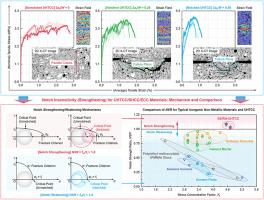Tensile fracture behavior and notch-insensitive mechanism of Strain-Hardening Cementitious Composites (SHCC) with recycled fine aggregates
IF 13.1
1区 工程技术
Q1 CONSTRUCTION & BUILDING TECHNOLOGY
引用次数: 0
Abstract
Enhancing the material sustainability and understanding the tensile fracture behavior of Ultra-High-Toughness Cementitious Composites (UHTCC) are of great significance for large-scale structural applications. In this study, we designed and developed green UHTCC incorporating recycled fine aggregates (RA) with the maximum particle sizes of 1.18, 2.36, and 4.75 mm. A comprehensive investigation of compressive strength, microstructures, and notched/unnotched tensile performance was conducted. Compared to silica sand UHTCC (SS-UHTCC), the compressive strength of RA-UHTCC decreased by 10.2 % and 12.2 % using 1.18- and 2.36-mm RA, respectively, due to weaker interfacial transition zones (ITZ), while UHTCC with 4.75-mm RA exhibited a slight increase in strength due to fewer ITZ. Unnotched tensile performance of RA-UHTCC showed slight reductions in tensile strength and ductility with increasing RA size, but all the RA-UHTCC maintained multiple cracking behavior. For notched tensile performance, the nominal tensile strength of RA-UHTCC was close to or slightly higher than their unnotched counterparts, with notch strength ratios (NSR) between 1.01 and 1.11. All the notched RA-UHTCC demonstrated multiple cracking, particularly in the notched regions, and the tensile ductility decreased with increasing notch length. Overall, UHTCC using 1.18- and 2.36-mm RA exhibited mechanical properties comparable to SS-UHTCC. All the RA-UHTCC displayed notch insensitivity and the NSR was higher than those of ordinary cementitious materials, alumina ceramic, and Poly (ethyl methacrylate) (PMMA) glass, and the mechanism behind it was also revealed.

再生细集料应变硬化胶凝复合材料(SHCC)拉伸断裂行为及缺口不敏感机理
提高材料的可持续性,了解超高韧性胶凝复合材料(UHTCC)的拉伸断裂行为,对大规模结构应用具有重要意义。在这项研究中,我们设计并开发了一种绿色的超细集料(RA),其最大粒径为1.18、2.36和4.75 mm。进行了全面的抗压强度,微观结构和缺口/非缺口拉伸性能的研究。与硅砂UHTCC (SS-UHTCC)相比,RA-UHTCC(1.18和2.36 mm)的抗压强度分别下降了10.2%和12.2%,这是由于界面过渡区(ITZ)较弱,而RA为4.75 mm的UHTCC的抗压强度略有提高,因为ITZ较少。RA- uhtcc的非缺口拉伸性能随着RA尺寸的增大,拉伸强度和塑性略有降低,但所有RA- uhtcc均保持多重开裂行为。缺口拉伸性能方面,RA-UHTCC的标称抗拉强度接近或略高于未缺口材料,缺口强度比(NSR)在1.01 ~ 1.11之间。所有缺口RA-UHTCC均表现出多重裂纹,特别是在缺口区域,并且拉伸塑性随缺口长度的增加而降低。总的来说,使用1.18和2.36毫米RA的UHTCC表现出与SS-UHTCC相当的机械性能。所有RA-UHTCC均表现出缺口不敏感,且NSR高于普通胶凝材料、氧化铝陶瓷和聚甲基丙烯酸乙酯(PMMA)玻璃,并揭示了其机理。
本文章由计算机程序翻译,如有差异,请以英文原文为准。
求助全文
约1分钟内获得全文
求助全文
来源期刊

Cement & concrete composites
工程技术-材料科学:复合
CiteScore
18.70
自引率
11.40%
发文量
459
审稿时长
65 days
期刊介绍:
Cement & concrete composites focuses on advancements in cement-concrete composite technology and the production, use, and performance of cement-based construction materials. It covers a wide range of materials, including fiber-reinforced composites, polymer composites, ferrocement, and those incorporating special aggregates or waste materials. Major themes include microstructure, material properties, testing, durability, mechanics, modeling, design, fabrication, and practical applications. The journal welcomes papers on structural behavior, field studies, repair and maintenance, serviceability, and sustainability. It aims to enhance understanding, provide a platform for unconventional materials, promote low-cost energy-saving materials, and bridge the gap between materials science, engineering, and construction. Special issues on emerging topics are also published to encourage collaboration between materials scientists, engineers, designers, and fabricators.
 求助内容:
求助内容: 应助结果提醒方式:
应助结果提醒方式:


